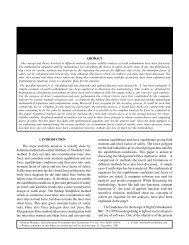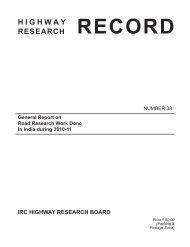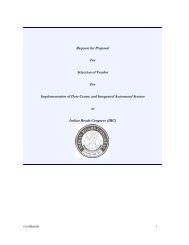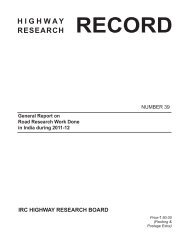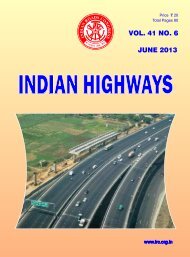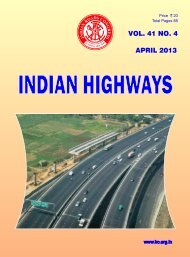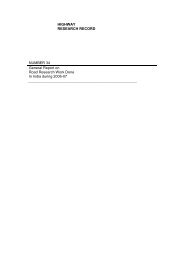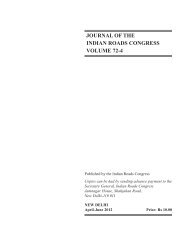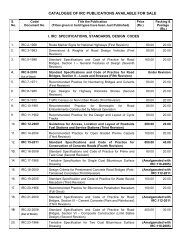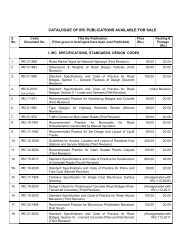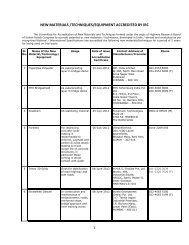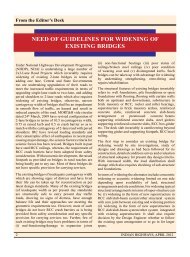A Review of Highway Agencies in the South Asia Region
A Review of Highway Agencies in the South Asia Region
A Review of Highway Agencies in the South Asia Region
You also want an ePaper? Increase the reach of your titles
YUMPU automatically turns print PDFs into web optimized ePapers that Google loves.
A <strong>Review</strong> <strong>of</strong> <strong>Highway</strong> <strong>Agencies</strong> <strong>in</strong> <strong>the</strong> <strong>South</strong> <strong>Asia</strong> <strong>Region</strong><br />
LOS C = Stable Flow<br />
LOS D = Approach<strong>in</strong>g Unstable Flow<br />
LOS E = Unstable Flow (Maximum Capacity)<br />
LOS F = Forced or Breakdown Flow<br />
In India, for example, a similar concept is followed and LOS ‘B’ is prescribed for design<br />
capacity <strong>of</strong> major arterial routes and LOS ‘C’ for o<strong>the</strong>r roads. Ch<strong>in</strong>a follows a system <strong>of</strong><br />
levels 1 to 4. For Class I highways, level 2 is adopted and this corresponds closely to LOS ‘C’<br />
<strong>of</strong> USA’s HCM. Of late, PPP projects for four-lan<strong>in</strong>g <strong>in</strong> India follow a design based on LOS<br />
‘B’; however, a hold<strong>in</strong>g service volume correspond<strong>in</strong>g to LOS ‘C’ is permissible for fur<strong>the</strong>r<br />
augmentation to six lanes.<br />
At service level ‘B’, <strong>the</strong> volume <strong>of</strong> traffic is nearly 0.5 times <strong>the</strong> maximum capacity, and at<br />
‘C’ nearly 0.7 times <strong>the</strong> maximum capacity. The HCM does not <strong>in</strong>dicate much difference<br />
between <strong>the</strong> average speeds <strong>of</strong> LOS ‘B’ and LOS ‘C’ but <strong>the</strong>re is an approximate 40 percent<br />
<strong>in</strong>crease <strong>in</strong> <strong>the</strong> volume <strong>of</strong> traffic handled at LOS ‘C’ and <strong>the</strong> traffic rema<strong>in</strong>s <strong>in</strong> stable flow<br />
condition. The benchmarks proposed for comput<strong>in</strong>g Network Congestion Indices are<br />
<strong>in</strong>dicated <strong>in</strong> Table A4:<br />
Table A4: Benchmarks for comput<strong>in</strong>g Network Congestion Indices<br />
Traffic Performance Volume/Capacity Ratio<br />
Congestion free Up to 0.70<br />
Congested Between 0.70 and 1.00<br />
Over-congested Above 1.00<br />
The follow<strong>in</strong>g steps can be adopted to compute <strong>the</strong> congestion <strong>in</strong>dices <strong>of</strong> <strong>the</strong> CRN:<br />
Step 1: Based on analysis <strong>of</strong> traffic volume and capacity <strong>of</strong> <strong>the</strong> road (this will depend upon<br />
<strong>the</strong> number <strong>of</strong> traffic lanes and presence <strong>of</strong> paved shoulders), <strong>the</strong> volume/capacity ratios<br />
will be established at <strong>the</strong> beg<strong>in</strong>n<strong>in</strong>g <strong>of</strong> each year for <strong>the</strong> entire CRN. This <strong>in</strong>formation would<br />
be available for different categories <strong>of</strong> roads, that is, NHs, SHs, MDRs and O<strong>the</strong>r Roads<br />
compris<strong>in</strong>g <strong>the</strong> CRN and also for various carriageway configurations, for example, less than<br />
two lane, two lane and four lane or more.<br />
Step 2: Tabulate <strong>the</strong> results and compute <strong>the</strong> congestion <strong>in</strong>dices consider<strong>in</strong>g <strong>the</strong> extent <strong>of</strong><br />
volume/capacity ratios on <strong>the</strong> length <strong>of</strong> <strong>the</strong> CRN as <strong>in</strong>dicated <strong>in</strong> Table A5.<br />
Table A5: Computation <strong>of</strong> congestion <strong>in</strong>dices<br />
Volume/capacity Ratio Percent Length <strong>of</strong> CRN Level <strong>of</strong> Congestion<br />
Up to 0.70 x 1 Congestion free<br />
Between 0.70 and 1.00 x 2 Congested<br />
Above 1.00 x 3 Over congested<br />
The higher <strong>the</strong> percentage <strong>of</strong> congestion free network, that is, <strong>the</strong> value <strong>of</strong> x 1 , <strong>the</strong> better<br />
<strong>the</strong> performance <strong>of</strong> <strong>the</strong> road sector and <strong>the</strong> agency. The percentage <strong>of</strong> over-congested<br />
network, that is, <strong>the</strong> value <strong>of</strong> x 3 would serve as an <strong>in</strong>dicator to <strong>the</strong> highway agency to plan<br />
capacity augmentation <strong>in</strong>vestments to meet <strong>the</strong> traffic demand on such road networks.<br />
Indicator 21: Network Quality Index (NQI)<br />
This <strong>in</strong>dicator is <strong>in</strong>tended to capture <strong>the</strong> quality <strong>of</strong> <strong>the</strong> network. To start with, <strong>the</strong> NQI may<br />
be determ<strong>in</strong>ed based on <strong>the</strong> parameter <strong>of</strong> rid<strong>in</strong>g quality <strong>in</strong> terms <strong>of</strong> roughness expressed<br />
83



